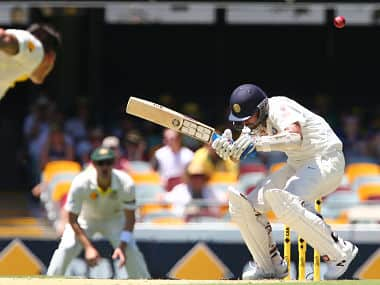They say practice makes perfect and India’s collapses on ‘away’ tours have now achieved a practiced ease that only comes after spending hours in the nets doing nothing. We have come to expect the collapses with the kind of certainty that accompanies the rising of the sun and the moon and that reflects the sad state of affairs in Indian cricket team. It also tells us why India struggles so much on away tours. It also reflects not so much the inexperience of this team as the lack of outright resolve to stand tall in tough times. Since the first Test of the series in England – with the exception of the second innings of the Lord’s Test (which India went on to win) – India have collapsed virtually each time they have walked out to bat. On this tour itself, India has shown that they are very consistent in the collapse department. In Adelaide – 77/6 in 22.4 overs and 73/8 in 18.1 overs. In Brisbane – 87/6 in 24.1 overs and 148/9 in 38.3 overs. Collapses defeat the hard work done to that point and also tell the opposition that they always have a chance. They could easily see that Mitchell Johnson was in the middle of a torrid spell this morning but no one tried to play him out. No one tried to just stay in the middle. No one took blows on the body like Jimmy Amarnath used to. He doesn’t even bowl long spells. So it would have been a case of playing out 4-5 overs… instead, they just meekly collapsed. [caption id=“attachment_1916051” align=“alignleft” width=“380”]  India’s batsman have found new ways to collapse in every game. AP[/caption] It might have been easy to dismiss the odd collapse as an aberration but this happens in every Test and it points to a greater malaise; it points to an inability to bide their time; it points to the tendency to keep attacking with little regard to match situation. Is this Mahendra Singh Dhoni’s legacy? A positive approach in Test cricket isn’t just going after the opposition bowlers. Rather, sometimes it is also means just standing up to the opponent and frustrating them. But India don’t subscribe to the ‘keep calm’ theory anymore. It is attack, attack, and attack and with that approach comes the inherent danger of a collapse. Here’s a quick look at each ‘away’ collapse India have had since July 2014: 344-5 to 346-9 – Nottingham, 1st innings 140-1 to 184-4 – Nottingham, 2nd innings 145-7 – Lord’s, 1st innings Lord’s, 2nd innings – no collapse, India won Southampton, 1st innings – no collapse but top score was Rahane’s 54. 80-2 to 178 all out – Southampton, 2nd innings 8-4, 62-4 to 152 all out - Old Trafford, 1st innings 53-1 to 161 all out – Old Trafford, 2nd innings 26-2 to 90-9 - Kensington Oval, London, 1st innings 94 all out - Kensington Oval, London, 2nd innings 367-4 to 444 all out – Adelaide, 1st innings 277-4 to 315 all out – Adelaide, second innings 321-4 to 408 all out – Brisbane, 1st innings 76-1 to 87-5 – Brisbane, 2nd innings In virtually all of these matches, there never seemed to be the thought that perhaps we should first stem the flow of wickets and play out a session. Not giving away wickets is also a way to win a session in a Test match. But sadly, India’s thought process, now, seems to be to outscore opponents; to outhit them and not to out-think them. The tactical slip-ups of this outfit just keep adding up. One Indian batsman who has done well in this period is Murali Vijay and he has spoken about how he abandoned his instinctively attacking style for the sake of the team. Why have other players not been able to adapt in much the same way? Strike-rates are important in Test cricket too but while they can give your bowlers more time to bowl out the opposition – there is also a need to balance aggression with periods of sustained defense especially when the bowlers are in the middle of a good spell. India, however, are like a runaway train with shot brakes – if they get on a good thing… fine. But if something goes wrong, there is no safety net. It feels like an accident waiting to happen. This is exactly the kind of situation where the likes of Rahul Dravid, Sachin Tendulkar and VVS Laxman would be immense for the Indian team in the past. They would buckle down, bide their time and sometimes it is important to not rush things. A lot of these players have played with the trio but few of them have picked up the important life lessons from them. Just sharing the dressing room and listening to anecdotes isn’t going to help them in the middle. It’s not as if India didn’t collapse in the old days. We did. And it took time for Laxman and Co to learn their their way around that corner but for us to allow those lessons to be forgotten so easily smacks of exactly the kind of attitude that India can do without. India are already 0-2 down in the series and if they can’t get their act together, then the possibility of another whitewash is starting to look very, very real.
India are like a runaway train with shot brakes – if they get on a good thing… fine. But if something goes wrong, there is no safety net.
Advertisement
End of Article


)

)
)
)
)
)
)
)
)



